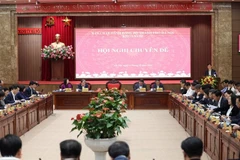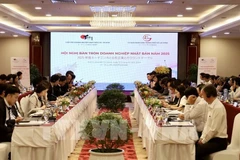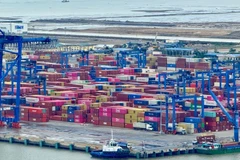 A statue of a bull and bear outside the HCM City Stock Exchange. Switching listing to HNX can help mitigate the overload of the transaction system at HoSE while waiting for the completion of a new technology system for the whole market. (Photo: hsx.vn)
A statue of a bull and bear outside the HCM City Stock Exchange. Switching listing to HNX can help mitigate the overload of the transaction system at HoSE while waiting for the completion of a new technology system for the whole market. (Photo: hsx.vn) He said such a move aimed to help mitigate the overload of the transactionsystem at HoSE while awaiting the completion of a new technology system for thewhole market, he said.
Since the end of 2020, Vietnam's stock market has witnessed a booming tradingperiod with multi-session liquidity of more than 15 trillion VND (653.2 millionUSD).
The wave of new investors entering the stock market has helped set newliquidity records, which is a positive signal for the market, he said.
As interest rates are still at low levels and people's understanding of thefinancial market is improving, this can be considered a very favourable periodfor attracting investors and developing Vietnam's stock market.
However, skyrocketing liquidity has far exceeded market forecasts, leading tofrequent congestion in many sessions, causing a lot of trouble for investorsand affecting the quality of the market.
“The sudden increase in liquidity recently is unpredictable, causing undesiredinterruptions in trading,” said Le Hai Tra, Chairman of the Board of Members ofHoSE.
“To tackle this issue, the State Securities Commission said it was speeding upthe implementation of a new information technology system for the entire stockmarket, known as KRX.
“However, due to the impact of the COVID-19 pandemic, the implementation of thenew system is delayed and if the disease progresses more complexly, it will bedifficult to continue the plan,” he said.
In the short term, one of the solutions applied by the State SecuritiesCommission (SSC) is to increase the minimum trading volume for a transaction onHoSE from 10 to 100 shares to help reduce the burden on the transaction system.
Although officially in place at the beginning of 2021, congestion still occurswhen investors flock into the market and push the liquidity to new heights,sometimes reaching 1 billion USD per session.
The SSC has also instructed the HoSE to request securities companies to review,limit errors arising from the companies’ processes, limiting automatictransactions to avoid negative impacts on the system, to check internalcontrol, control risks, limit errors that may occur in the trading system andarrange staff on shift duty at peak transaction times.
In the short term, as the KRX system is not immediately available while tradingdemand is huge, a temporary solution is to transfer some companies from HoSE toHNX, said Quynh.
This can be considered as an appropriate step because the Prime Minister issuedDecision 37/2020/QD-TTg to establish the Vietnam Stock Exchange (VietnamExchange), based on the merger between HoSE and HNX.
“This is the quickest and least costly solution at the time being. This willnot only help to reduce the overload on the HoSE system but also ensure thesmooth transaction of the Vietnamese stock market, meeting the legitimatetrading needs of investors, ensuring credit of the stock market in the eyes ofdomestic and foreign investors, maintain an effective capital mobilisationchannel for enterprises in the economy,” he said.
If the SSC approves and facilitates administrative procedures for companies toswitch from the HoSE to HNX, VNDirect will volunteer to help them with thetransferring procedures, Quynh added./.





























